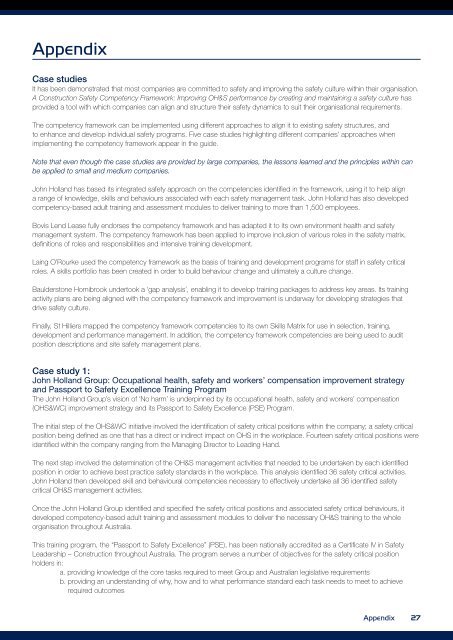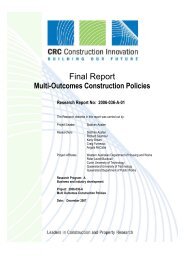A Practical Guide to Safety Leadership Book (PDF 5MB) - QUT ePrints
A Practical Guide to Safety Leadership Book (PDF 5MB) - QUT ePrints
A Practical Guide to Safety Leadership Book (PDF 5MB) - QUT ePrints
You also want an ePaper? Increase the reach of your titles
YUMPU automatically turns print PDFs into web optimized ePapers that Google loves.
Appendix<br />
Case studies<br />
It has been demonstrated that most companies are committed <strong>to</strong> safety and improving the safety culture within their organisation.<br />
A Construction <strong>Safety</strong> Competency Framework: Improving OH&S performance by creating and maintaining a safety culture has<br />
provided a <strong>to</strong>ol with which companies can align and structure their safety dynamics <strong>to</strong> suit their organisational requirements.<br />
The competency framework can be implemented using different approaches <strong>to</strong> align it <strong>to</strong> existing safety structures, and<br />
<strong>to</strong> enhance and develop individual safety programs. Five case studies highlighting different companies’ approaches when<br />
implementing the competency framework appear in the guide.<br />
Note that even though the case studies are provided by large companies, the lessons learned and the principles within can<br />
be applied <strong>to</strong> small and medium companies.<br />
John Holland has based its integrated safety approach on the competencies identified in the framework, using it <strong>to</strong> help align<br />
a range of knowledge, skills and behaviours associated with each safety management task. John Holland has also developed<br />
competency-based adult training and assessment modules <strong>to</strong> deliver training <strong>to</strong> more than 1,500 employees.<br />
Bovis Lend Lease fully endorses the competency framework and has adapted it <strong>to</strong> its own environment health and safety<br />
management system. The competency framework has been applied <strong>to</strong> improve inclusion of various roles in the safety matrix,<br />
definitions of roles and responsibilities and intensive training development.<br />
Laing O’Rourke used the competency framework as the basis of training and development programs for staff in safety critical<br />
roles. A skills portfolio has been created in order <strong>to</strong> build behaviour change and ultimately a culture change.<br />
Baulders<strong>to</strong>ne Hornibrook under<strong>to</strong>ok a ‘gap analysis’, enabling it <strong>to</strong> develop training packages <strong>to</strong> address key areas. Its training<br />
activity plans are being aligned with the competency framework and improvement is underway for developing strategies that<br />
drive safety culture.<br />
Finally, St Hilliers mapped the competency framework competencies <strong>to</strong> its own Skills Matrix for use in selection, training,<br />
development and performance management. In addition, the competency framework competencies are being used <strong>to</strong> audit<br />
position descriptions and site safety management plans.<br />
Case study 1:<br />
John Holland Group: Occupational health, safety and workers’ compensation improvement strategy<br />
and Passport <strong>to</strong> <strong>Safety</strong> Excellence Training Program<br />
The John Holland Group’s vision of ‘No harm’ is underpinned by its occupational health, safety and workers’ compensation<br />
(OHS&WC) improvement strategy and its Passport <strong>to</strong> <strong>Safety</strong> Excellence (PSE) Program.<br />
The initial step of the OHS&WC initiative involved the identification of safety critical positions within the company; a safety critical<br />
position being defined as one that has a direct or indirect impact on OHS in the workplace. Fourteen safety critical positions were<br />
identified within the company ranging from the Managing Direc<strong>to</strong>r <strong>to</strong> Leading Hand.<br />
The next step involved the determination of the OH&S management activities that needed <strong>to</strong> be undertaken by each identified<br />
position in order <strong>to</strong> achieve best practice safety standards in the workplace. This analysis identified 36 safety critical activities.<br />
John Holland then developed skill and behavioural competencies necessary <strong>to</strong> effectively undertake all 36 identified safety<br />
critical OH&S management activities.<br />
Once the John Holland Group identified and specified the safety critical positions and associated safety critical behaviours, it<br />
developed competency-based adult training and assessment modules <strong>to</strong> deliver the necessary OH&S training <strong>to</strong> the whole<br />
organisation throughout Australia.<br />
This training program, the “Passport <strong>to</strong> <strong>Safety</strong> Excellence” (PSE), has been nationally accredited as a Certificate IV in <strong>Safety</strong><br />
<strong>Leadership</strong> – Construction throughout Australia. The program serves a number of objectives for the safety critical position<br />
holders in:<br />
a. providing knowledge of the core tasks required <strong>to</strong> meet Group and Australian legislative requirements<br />
b. providing an understanding of why, how and <strong>to</strong> what performance standard each task needs <strong>to</strong> meet <strong>to</strong> achieve<br />
required outcomes<br />
Appendix 27

















